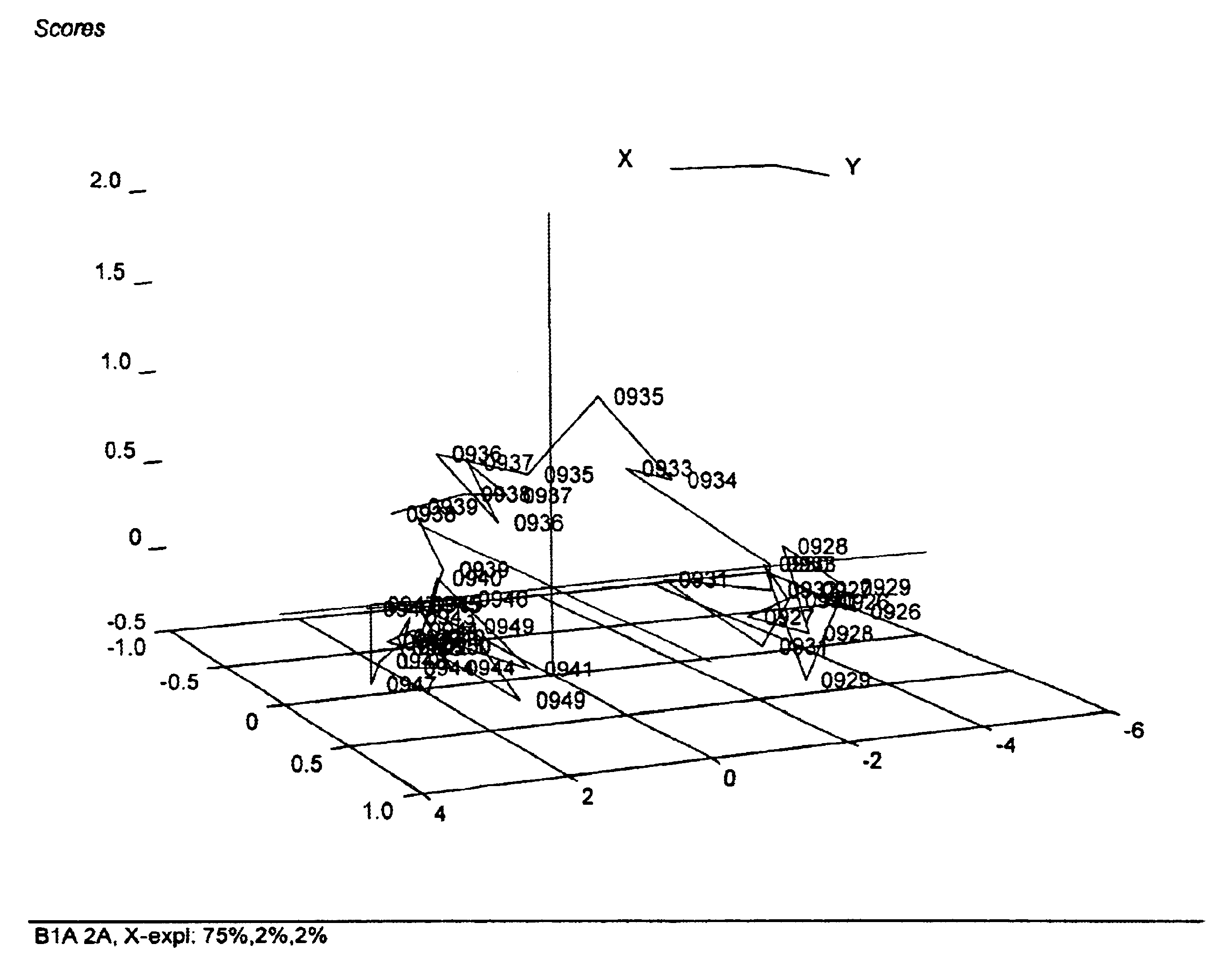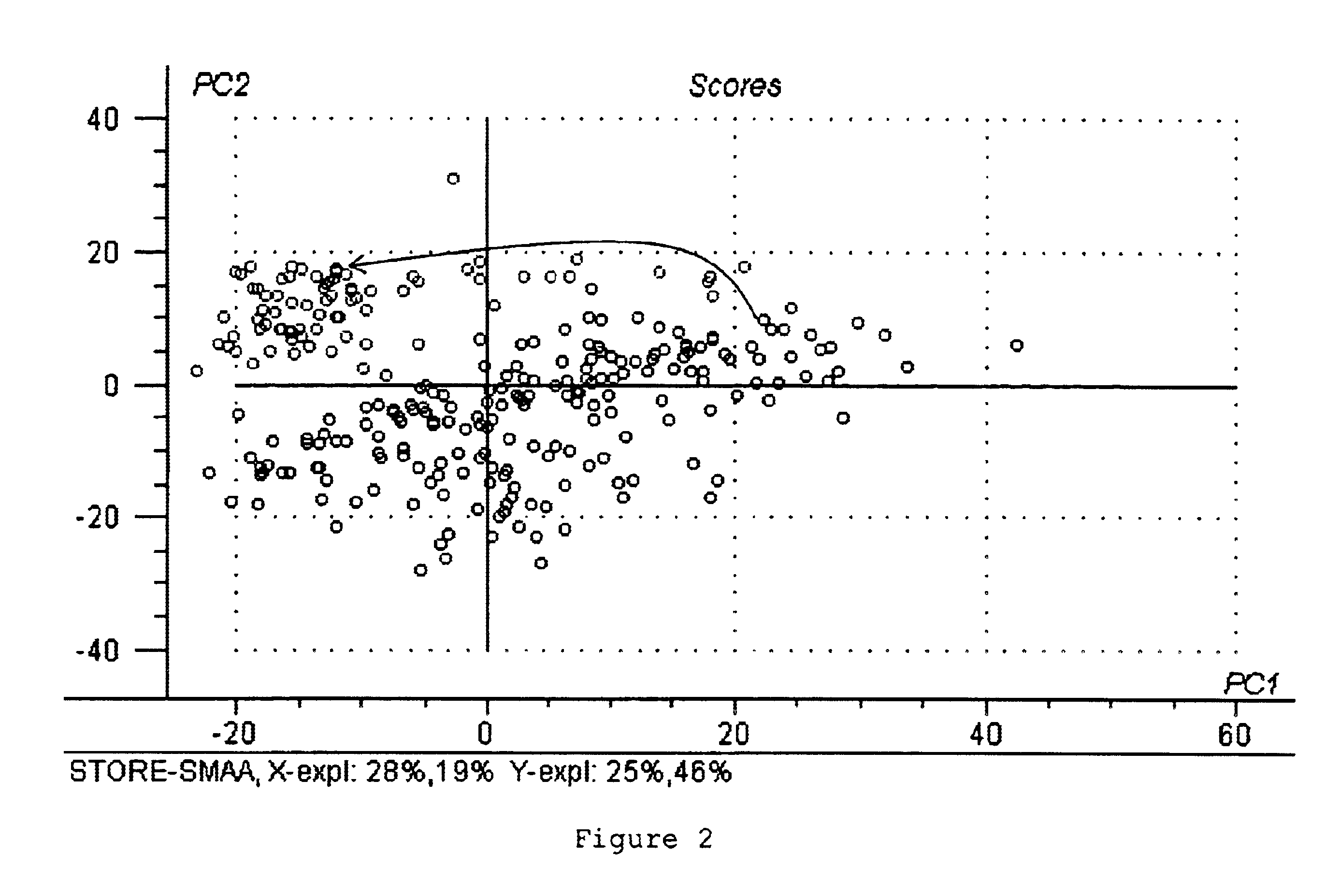Method of analyzing granular composition by acoustic emission
a technology of acoustic emission and granular composition, which is applied in the direction of vibration measurement in solids, instruments, and processing of detected response signals, etc., can solve the problems of granular compositions falling outside the expected properties, process instability, etc., and achieves improved product properties, safe handling, and more commercial attractive
- Summary
- Abstract
- Description
- Claims
- Application Information
AI Technical Summary
Benefits of technology
Problems solved by technology
Method used
Image
Examples
example 1
[0095]Effects of changing amount of fiber material in a granulation process as measured with acoustic emission analysis.
[0096]In continuous high shear mixer granulation process the amount of cellulose fiber supplied to the granulation process was changed at a given time. The granulator was mounted with an accelerometer for detection of vibrations. The accelerometer was placed on the interconnecting section between two mixers placed in series. The vibrations from 43 Hz to 25 kHz were recorded during the change of fiber supply and the recorded data were first treated with FFT (Fast Fourier Transformation). The FFT analysis was performed (according to the vendors manual) with 512 lines with Hanning window and 50% overlap. All FFT spectra obtained in 5 seconds (500 spectra) were linearly averaged to Power Spectral Density (PSD) (according to the vendors manual) every 30 seconds to remove noise. Subsequently the data was processed using Principal Component Analysis (PCA) and a score plot...
example 2
Positioning Accelerometers
[0100]In this example the effect of different positioning of accelerometers were tested when changing the amount of binder to a continuous granulation process. 4 accelerometers were placed close to each other on the same horizontal line on a high shear mixer granulator and this configuration was expected to give only small time delays between the accelerometers. This was not the case. The first accelerometer on the line detected a change in binder as expected while the second, third and fourth accelerometer did not detect the change at all or detected the change very poorly. This shows that the placement of the accelerometers is important when using acoustic emission for detecting changes in granulate characteristics. Same equipment as in example 1 was used except the accelerometers were type 4502 / 4503 from Brüel & Kjær.
example 3
Small and Large Granules
[0101]In this example the amount of cellulose was increased from an average of 8.5% to an average of 11%. The change in amount of cellulose results in a decrease in particle size.
[0102]The accelerometer was placed mid on the rear side of the mixer granulator.
[0103]The vibrations from 32 Hz to 25.6 kHz were recorded during the process and treated with FFT (Fast Fourier Transformation). The FFT analysis was performed with 800 lines with Hanning window and 50% overlap. All FFT spectra obtained in 1.5 seconds (95 spectra) was exponentially averaged to Power Spectral Density (PSD) every 60 second to remove noise. Subsequently the data was processed using Principal component regression (PCR) and a score plot was generated as depicted in FIG. 2. One dot in the score plot represents a PSD spectrum. The PCR was carried out with the PSD spectra as x-data and a classification variable identifying PSD spectra to be related to small and large granules as Y-data. The score...
PUM
| Property | Measurement | Unit |
|---|---|---|
| frequency | aaaaa | aaaaa |
| frequency | aaaaa | aaaaa |
| size | aaaaa | aaaaa |
Abstract
Description
Claims
Application Information
 Login to View More
Login to View More - R&D
- Intellectual Property
- Life Sciences
- Materials
- Tech Scout
- Unparalleled Data Quality
- Higher Quality Content
- 60% Fewer Hallucinations
Browse by: Latest US Patents, China's latest patents, Technical Efficacy Thesaurus, Application Domain, Technology Topic, Popular Technical Reports.
© 2025 PatSnap. All rights reserved.Legal|Privacy policy|Modern Slavery Act Transparency Statement|Sitemap|About US| Contact US: help@patsnap.com



